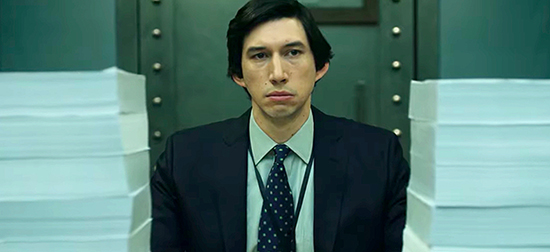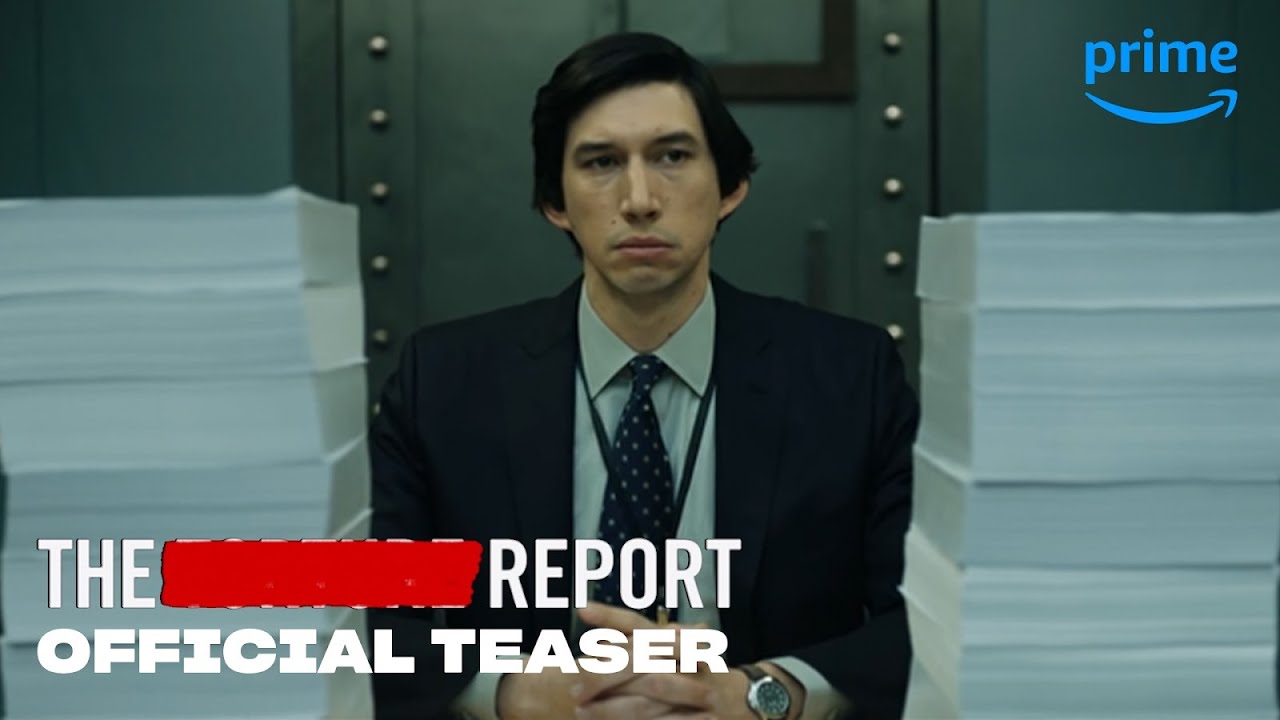Who guards the guards? Questions of oversight and accountability are at the centre of Scott Z. Burns’ The Report, based on the real-life creation of the Senate Select Committee report on C.I.A. and U.S. government use of torture. The film follows Daniel Jones (Adam Driver), a Senate staffer, who leads the seven-year investigation into abuses following 9/11. Working for Senator Dianne Feinstein (Annette Bening), Jones and a small team of investigators piece together a paper trail of the who, where and when of the development, roll out and systematisation of ‘Extreme Interrogation Techniques’ – torture methods that include the water-boarding, fake burial and extreme beatings of illegally detained terror suspects. As the torture report progresses, Jones and Feinstein find the path to publication blocked, both by the director of the C.I.A., John Brennan (Ted Levine), and Obama’s White House Chief of Staff Denis McDonough (John Hamm). The Report positions itself as an investigation into both C.I.A. abuse and the ability of the U.S. political establishment to hold itself to account.
The film is set in the plush, bright Washington corridors of power and the dark, concrete breezeblock basement where Jones carries out his research. Two different aesthetics; two separate modes of operating. Jones’ office is piled high with paperwork, post-its and coffee cups, the long accumulated detritus of hard work. In contrast, fast-talking C.I.A. staffers glide through glass offices, their endless streams of national security jargon, ‘learned helplessness’ and ‘enhanced interrogation,’ masking and enabling rapid moral slippages. Rapid-fire scenes show decisions made too quickly, without oversight. By contrast, Jones’ scenes are slower, the camera lingers on his face, watching his methodical, solitary consideration of the evidence in front of him. We are anchored in Jones’s moral and narrative perspective. The documents he reads are highlighted on screen, cropped hard to focus on key phrases. The captions simplify the long streams of explanatory and investigative dialogue, showing the horrors of C.I.A. abuses through Jones’ eyes, getting behind the jargon to state in bold typeface that these are ‘war crimes’ and ‘human rights violations.’
These conflicting visions of Washington politics are punctuated with graphic visualistions of torture at the U.S. blacksites where C.I.A. interrogations took place. Extended scenes show the physical humiliation, harm and death suffered by detainees, deafeningly soundtracked by the death metal used to deprive sleep and disorientate. By intercutting torture with the formal investigation on Capitol Hill, the film draws structural lines of culpability between policy makers and black site operatives. The depictions of torture viscerally dramatise the dry text of the C.I.A. memos that Jones is immersed in, but there is a sense in which these scenes are politically misleading. By weaving depictions of the black sites into the overall structure of the narrative, lending it the same sense of documentary realism or journalistic reportage as Jones’ research, the film suggests more oversight than in fact existed. Destroyed by the C.I.A., no video evidence of government torture was reviewed. Blacksites stay dark. The film reconstructs these unrecorded atrocities, but these stylised, fast cropping scenes can’t communicate the appalling sense of duration of one who, like, Abu Zubaydah, was locked in a coffin-sized box for 266 hours.
Scenes in which Jones watches Katherine Bigelow’s Zero Dark Thirty or rails against the moral shortcomings of Jack Bauer in the Fox TV show 24 suggest an arch, metacritical attitude to the culture industry which arose in the aftermath of 9/11 and failed to present a moral argument against the perceived exigencies of torture. Yet The Report succumbs to similar pitfalls. Why is torture wrong? Is it a question of morality or dubious efficacy? As the film builds, the latter justification – that torture is bad because it doesn’t work – takes precedence in the dialogue.
The script was developed out of the 6,700-page report from which the film takes its name. A lack of critical distance from this source material could explain its blind spots, echoing the legalistic objections of Congress, rather than presenting a moral condemnation of torture practices. The Report is critical of the C.I.A. lawyers who, in the aftermath of 9/11, scrambled to find legal loopholes to justify Enhanced Interrogation Techniques, who argued that the causing of ‘severe pain’ was legal, as long as it produced actionable intelligence. But the film fails to present a consistent moral case. The grim logic that, as one character explains, torture is ‘only legal if it works’, cannot be seriously undermined by the reverse position – which the film adopts – that torture should be illegal because it ‘does not work’, the argument put forward in a recent interview with the film’s director, Scott Z. Burns.
Where the film does take a moral stance, it is often inconsistent. The choppy, non-linear timeline means that The Report has a wide scope to examine the structures and ideologies of American politics, reaching backwards and forwards in time to highlight particular abuses of power or good conduct. This god’s-eye-view perspective sets up a framework to contrast good with bad; Congress vs. C.I.A., due process vs. extrajudicial punishment, interrogation vs. torture. There are gaps in this overview, however – the film makes little reference to the racism and imperial politics at the heart of these issues. One scene depicts night time on a dark airstrip, a hand-held camera sways in and out of focus and a detainee cries out in fear, bound to a stretcher. Cutting to a sparse room, we see him laid out with an untreated gunshot wound as he is rehydrated with an ice cube. He’s thirsty and in pain, and when questioned by an F.B.I. agent, he gives answers. This, the film suggests, is how interrogation should be done, this is when it works. As the investigator leaves he offers the detainee, still lying in agony, a Pepsi. The film tries to code an image of American foreign policy as its best – but only succeeds in showing moral relativism with a dash of product placement.
What does the torture discourse say about America? For The Report, the central focus is a fault line caused by the trauma of 9/11 which saw traditional American liberalism on the run from the neo-Conservative Right. When the film opens in Washington, the audience is denied the usual establishing aerial shot of the city. Instead we see Jones, digital camera in hand, take a hopeful, tourist-style photo of the buildings. As the film progresses, shots of the Washington Monument are intercut with scenes of C.I.A. mendacity. The nation and its symbols are in crisis.
Only over the final credits do we see the full spread of Capitol Hill rise up reassuringly behind Jones, soundtracked by military music, the power and integrity of city and state seemingly restored. The final title of the film quotes George Washington’s condemnation of the use of torture, positioning Jones’ report as a reaffirmation of the Founding Fathers’ vision, presented here as one of freedom and justice. But of the issues raised earlier in the film – drone strikes, extraordinary rendition, indefinite detention without trial – the closing credits say nothing. For Senator Feinstein, the publication of the report is so important because America must be ‘confident enough to learn from its mistakes’. Yet, when the Guantanamo Bay Detention Centre remains open today, and extrajudicial drone killings take place every week, surely any recourse to American triumphalism is misplaced.
The Report is in cinemas now



